Diploma in Risk, Internal Audit & Compliance: Assignment 3 Report
VerifiedAdded on 2022/08/25
|12
|2789
|21
Report
AI Summary
This report presents a comprehensive analysis of the Volkswagen emissions scandal, examining the company's failures in risk management, internal audit, and compliance. The report is divided into two parts. Part A critically discusses the Volkswagen case study, focusing on four key areas: leadership style, corporate governance, sustainability issues, and rebuilding trust and relationships. It analyzes the structural issues within Volkswagen, including the lack of diversity in the supervisory board and the aggressive leadership style that contributed to the scandal. Part B provides a reflection on the student's personal learning, focusing on the expectations of an effective Head of Audit, including technical and non-technical skills, and the importance of leadership style in influencing risk and audit issues. The reflection highlights the key concerns for internal auditors, such as digitalization, cyber security, and talent management, and emphasizes the need for strong leadership to build effective audit teams and partner with businesses to improve risk control and management.
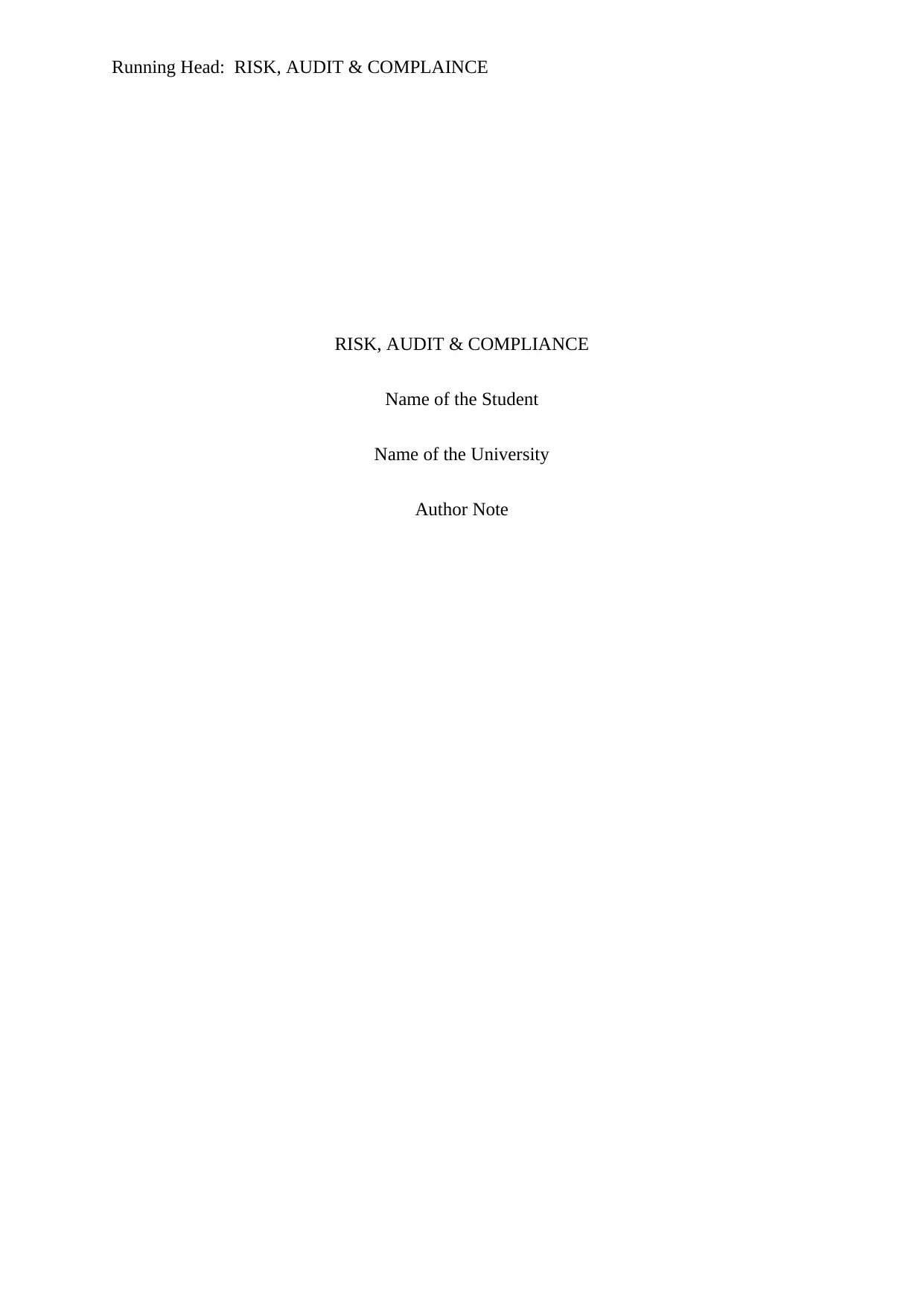
Running Head: RISK, AUDIT & COMPLAINCE
RISK, AUDIT & COMPLIANCE
Name of the Student
Name of the University
Author Note
RISK, AUDIT & COMPLIANCE
Name of the Student
Name of the University
Author Note
Paraphrase This Document
Need a fresh take? Get an instant paraphrase of this document with our AI Paraphraser
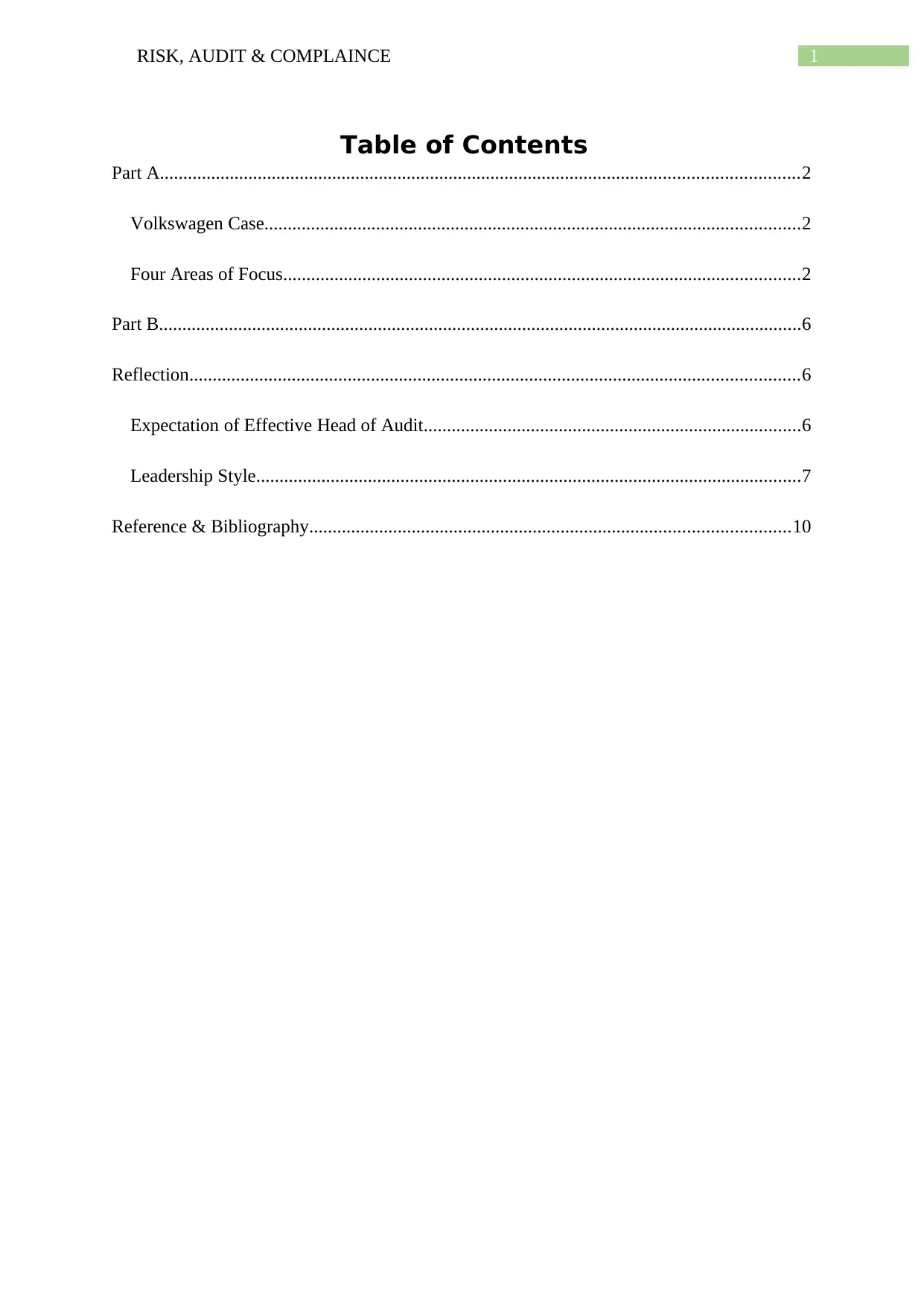
1RISK, AUDIT & COMPLAINCE
Table of Contents
Part A.........................................................................................................................................2
Volkswagen Case...................................................................................................................2
Four Areas of Focus...............................................................................................................2
Part B..........................................................................................................................................6
Reflection...................................................................................................................................6
Expectation of Effective Head of Audit.................................................................................6
Leadership Style.....................................................................................................................7
Reference & Bibliography.......................................................................................................10
Table of Contents
Part A.........................................................................................................................................2
Volkswagen Case...................................................................................................................2
Four Areas of Focus...............................................................................................................2
Part B..........................................................................................................................................6
Reflection...................................................................................................................................6
Expectation of Effective Head of Audit.................................................................................6
Leadership Style.....................................................................................................................7
Reference & Bibliography.......................................................................................................10
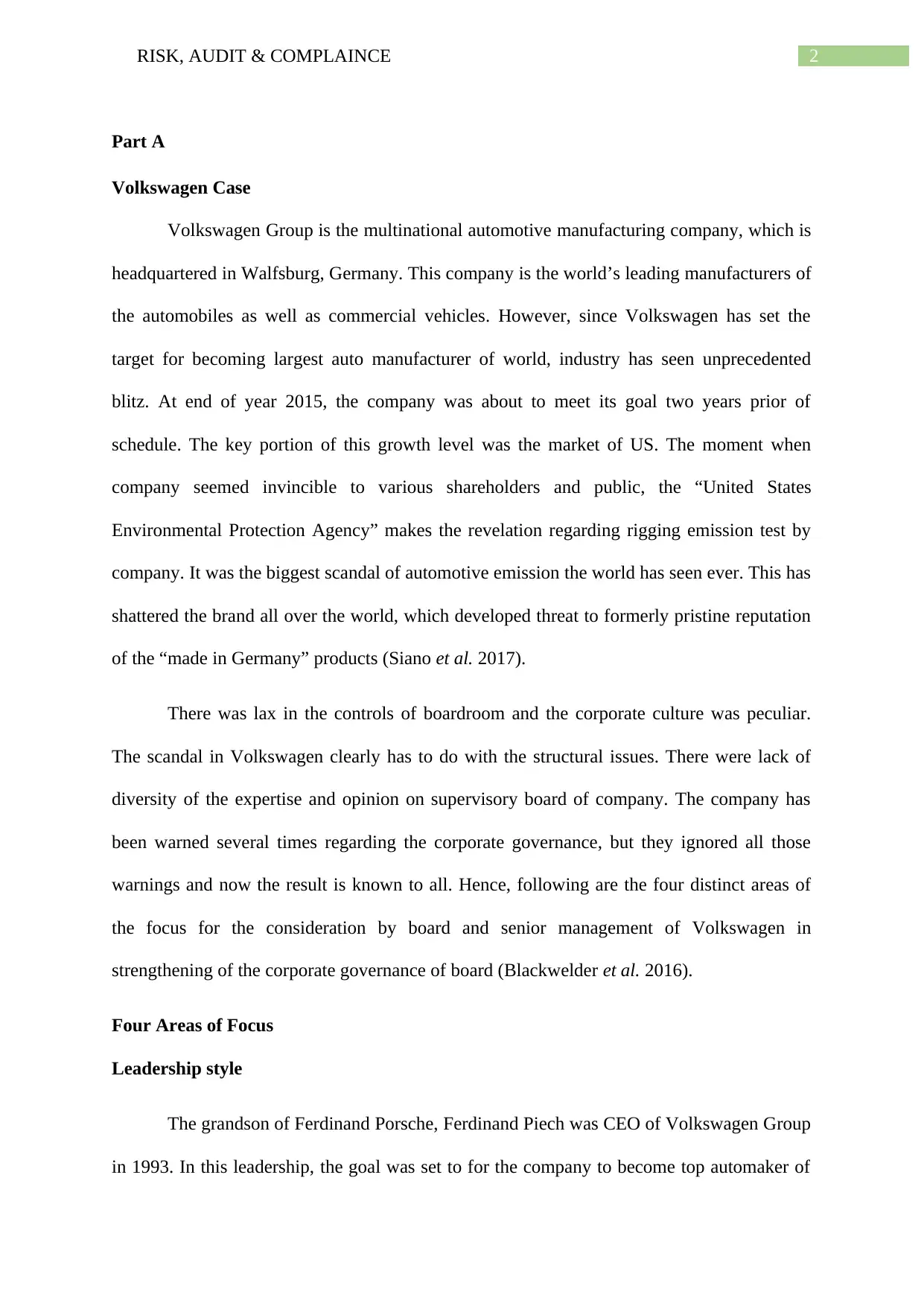
2RISK, AUDIT & COMPLAINCE
Part A
Volkswagen Case
Volkswagen Group is the multinational automotive manufacturing company, which is
headquartered in Walfsburg, Germany. This company is the world’s leading manufacturers of
the automobiles as well as commercial vehicles. However, since Volkswagen has set the
target for becoming largest auto manufacturer of world, industry has seen unprecedented
blitz. At end of year 2015, the company was about to meet its goal two years prior of
schedule. The key portion of this growth level was the market of US. The moment when
company seemed invincible to various shareholders and public, the “United States
Environmental Protection Agency” makes the revelation regarding rigging emission test by
company. It was the biggest scandal of automotive emission the world has seen ever. This has
shattered the brand all over the world, which developed threat to formerly pristine reputation
of the “made in Germany” products (Siano et al. 2017).
There was lax in the controls of boardroom and the corporate culture was peculiar.
The scandal in Volkswagen clearly has to do with the structural issues. There were lack of
diversity of the expertise and opinion on supervisory board of company. The company has
been warned several times regarding the corporate governance, but they ignored all those
warnings and now the result is known to all. Hence, following are the four distinct areas of
the focus for the consideration by board and senior management of Volkswagen in
strengthening of the corporate governance of board (Blackwelder et al. 2016).
Four Areas of Focus
Leadership style
The grandson of Ferdinand Porsche, Ferdinand Piech was CEO of Volkswagen Group
in 1993. In this leadership, the goal was set to for the company to become top automaker of
Part A
Volkswagen Case
Volkswagen Group is the multinational automotive manufacturing company, which is
headquartered in Walfsburg, Germany. This company is the world’s leading manufacturers of
the automobiles as well as commercial vehicles. However, since Volkswagen has set the
target for becoming largest auto manufacturer of world, industry has seen unprecedented
blitz. At end of year 2015, the company was about to meet its goal two years prior of
schedule. The key portion of this growth level was the market of US. The moment when
company seemed invincible to various shareholders and public, the “United States
Environmental Protection Agency” makes the revelation regarding rigging emission test by
company. It was the biggest scandal of automotive emission the world has seen ever. This has
shattered the brand all over the world, which developed threat to formerly pristine reputation
of the “made in Germany” products (Siano et al. 2017).
There was lax in the controls of boardroom and the corporate culture was peculiar.
The scandal in Volkswagen clearly has to do with the structural issues. There were lack of
diversity of the expertise and opinion on supervisory board of company. The company has
been warned several times regarding the corporate governance, but they ignored all those
warnings and now the result is known to all. Hence, following are the four distinct areas of
the focus for the consideration by board and senior management of Volkswagen in
strengthening of the corporate governance of board (Blackwelder et al. 2016).
Four Areas of Focus
Leadership style
The grandson of Ferdinand Porsche, Ferdinand Piech was CEO of Volkswagen Group
in 1993. In this leadership, the goal was set to for the company to become top automaker of
⊘ This is a preview!⊘
Do you want full access?
Subscribe today to unlock all pages.

Trusted by 1+ million students worldwide
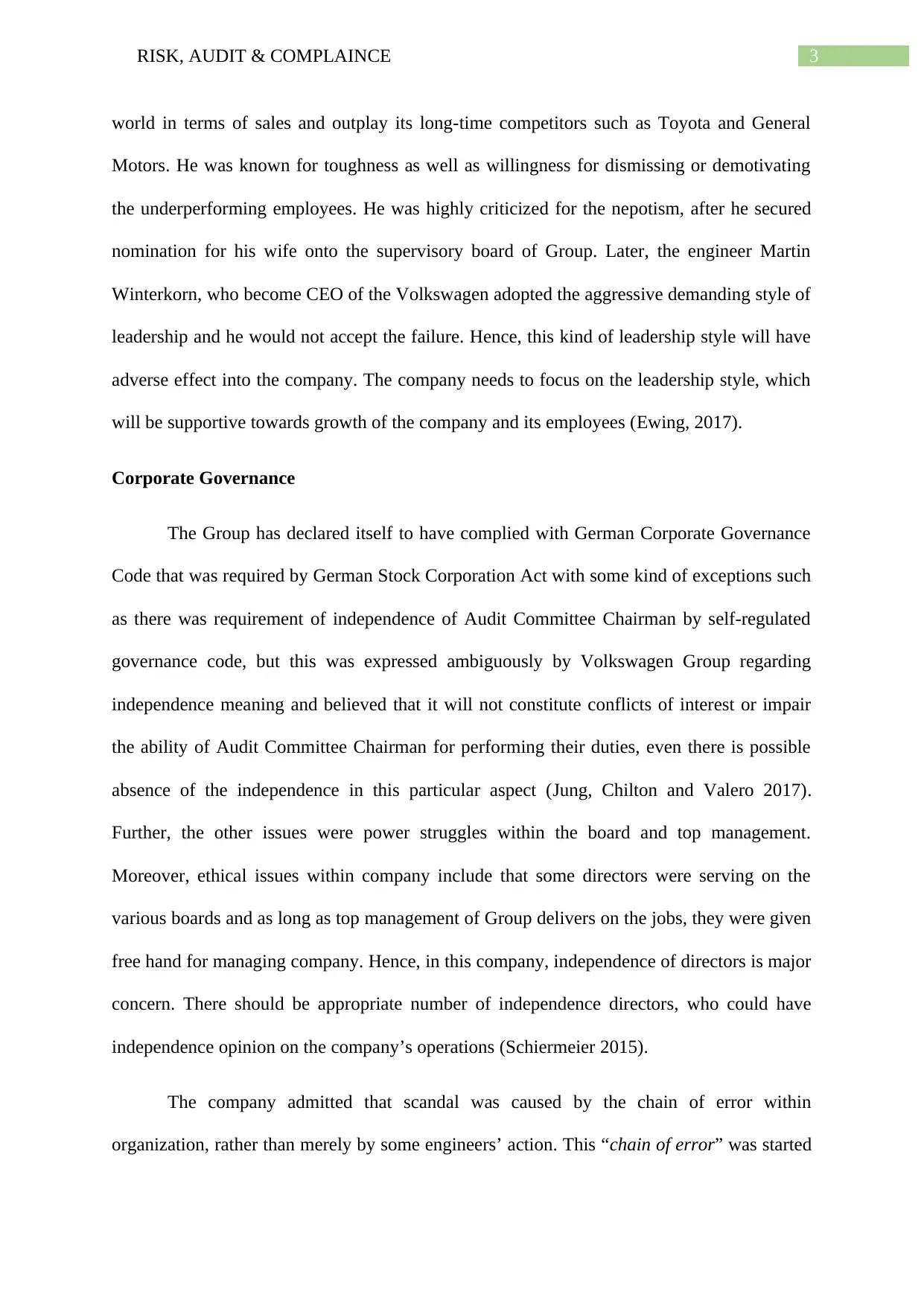
3RISK, AUDIT & COMPLAINCE
world in terms of sales and outplay its long-time competitors such as Toyota and General
Motors. He was known for toughness as well as willingness for dismissing or demotivating
the underperforming employees. He was highly criticized for the nepotism, after he secured
nomination for his wife onto the supervisory board of Group. Later, the engineer Martin
Winterkorn, who become CEO of the Volkswagen adopted the aggressive demanding style of
leadership and he would not accept the failure. Hence, this kind of leadership style will have
adverse effect into the company. The company needs to focus on the leadership style, which
will be supportive towards growth of the company and its employees (Ewing, 2017).
Corporate Governance
The Group has declared itself to have complied with German Corporate Governance
Code that was required by German Stock Corporation Act with some kind of exceptions such
as there was requirement of independence of Audit Committee Chairman by self-regulated
governance code, but this was expressed ambiguously by Volkswagen Group regarding
independence meaning and believed that it will not constitute conflicts of interest or impair
the ability of Audit Committee Chairman for performing their duties, even there is possible
absence of the independence in this particular aspect (Jung, Chilton and Valero 2017).
Further, the other issues were power struggles within the board and top management.
Moreover, ethical issues within company include that some directors were serving on the
various boards and as long as top management of Group delivers on the jobs, they were given
free hand for managing company. Hence, in this company, independence of directors is major
concern. There should be appropriate number of independence directors, who could have
independence opinion on the company’s operations (Schiermeier 2015).
The company admitted that scandal was caused by the chain of error within
organization, rather than merely by some engineers’ action. This “chain of error” was started
world in terms of sales and outplay its long-time competitors such as Toyota and General
Motors. He was known for toughness as well as willingness for dismissing or demotivating
the underperforming employees. He was highly criticized for the nepotism, after he secured
nomination for his wife onto the supervisory board of Group. Later, the engineer Martin
Winterkorn, who become CEO of the Volkswagen adopted the aggressive demanding style of
leadership and he would not accept the failure. Hence, this kind of leadership style will have
adverse effect into the company. The company needs to focus on the leadership style, which
will be supportive towards growth of the company and its employees (Ewing, 2017).
Corporate Governance
The Group has declared itself to have complied with German Corporate Governance
Code that was required by German Stock Corporation Act with some kind of exceptions such
as there was requirement of independence of Audit Committee Chairman by self-regulated
governance code, but this was expressed ambiguously by Volkswagen Group regarding
independence meaning and believed that it will not constitute conflicts of interest or impair
the ability of Audit Committee Chairman for performing their duties, even there is possible
absence of the independence in this particular aspect (Jung, Chilton and Valero 2017).
Further, the other issues were power struggles within the board and top management.
Moreover, ethical issues within company include that some directors were serving on the
various boards and as long as top management of Group delivers on the jobs, they were given
free hand for managing company. Hence, in this company, independence of directors is major
concern. There should be appropriate number of independence directors, who could have
independence opinion on the company’s operations (Schiermeier 2015).
The company admitted that scandal was caused by the chain of error within
organization, rather than merely by some engineers’ action. This “chain of error” was started
Paraphrase This Document
Need a fresh take? Get an instant paraphrase of this document with our AI Paraphraser
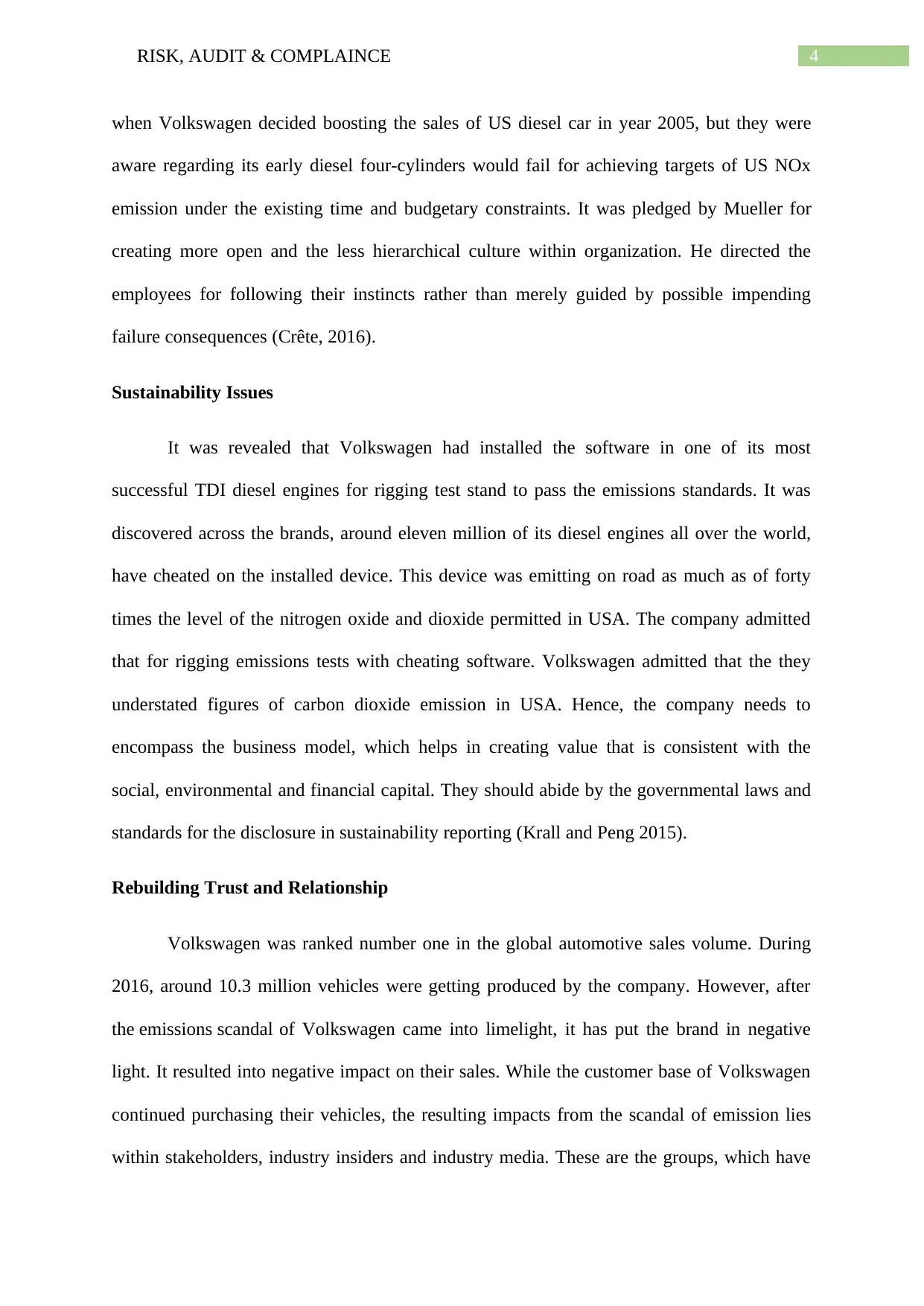
4RISK, AUDIT & COMPLAINCE
when Volkswagen decided boosting the sales of US diesel car in year 2005, but they were
aware regarding its early diesel four-cylinders would fail for achieving targets of US NOx
emission under the existing time and budgetary constraints. It was pledged by Mueller for
creating more open and the less hierarchical culture within organization. He directed the
employees for following their instincts rather than merely guided by possible impending
failure consequences (Crête, 2016).
Sustainability Issues
It was revealed that Volkswagen had installed the software in one of its most
successful TDI diesel engines for rigging test stand to pass the emissions standards. It was
discovered across the brands, around eleven million of its diesel engines all over the world,
have cheated on the installed device. This device was emitting on road as much as of forty
times the level of the nitrogen oxide and dioxide permitted in USA. The company admitted
that for rigging emissions tests with cheating software. Volkswagen admitted that the they
understated figures of carbon dioxide emission in USA. Hence, the company needs to
encompass the business model, which helps in creating value that is consistent with the
social, environmental and financial capital. They should abide by the governmental laws and
standards for the disclosure in sustainability reporting (Krall and Peng 2015).
Rebuilding Trust and Relationship
Volkswagen was ranked number one in the global automotive sales volume. During
2016, around 10.3 million vehicles were getting produced by the company. However, after
the emissions scandal of Volkswagen came into limelight, it has put the brand in negative
light. It resulted into negative impact on their sales. While the customer base of Volkswagen
continued purchasing their vehicles, the resulting impacts from the scandal of emission lies
within stakeholders, industry insiders and industry media. These are the groups, which have
when Volkswagen decided boosting the sales of US diesel car in year 2005, but they were
aware regarding its early diesel four-cylinders would fail for achieving targets of US NOx
emission under the existing time and budgetary constraints. It was pledged by Mueller for
creating more open and the less hierarchical culture within organization. He directed the
employees for following their instincts rather than merely guided by possible impending
failure consequences (Crête, 2016).
Sustainability Issues
It was revealed that Volkswagen had installed the software in one of its most
successful TDI diesel engines for rigging test stand to pass the emissions standards. It was
discovered across the brands, around eleven million of its diesel engines all over the world,
have cheated on the installed device. This device was emitting on road as much as of forty
times the level of the nitrogen oxide and dioxide permitted in USA. The company admitted
that for rigging emissions tests with cheating software. Volkswagen admitted that the they
understated figures of carbon dioxide emission in USA. Hence, the company needs to
encompass the business model, which helps in creating value that is consistent with the
social, environmental and financial capital. They should abide by the governmental laws and
standards for the disclosure in sustainability reporting (Krall and Peng 2015).
Rebuilding Trust and Relationship
Volkswagen was ranked number one in the global automotive sales volume. During
2016, around 10.3 million vehicles were getting produced by the company. However, after
the emissions scandal of Volkswagen came into limelight, it has put the brand in negative
light. It resulted into negative impact on their sales. While the customer base of Volkswagen
continued purchasing their vehicles, the resulting impacts from the scandal of emission lies
within stakeholders, industry insiders and industry media. These are the groups, which have
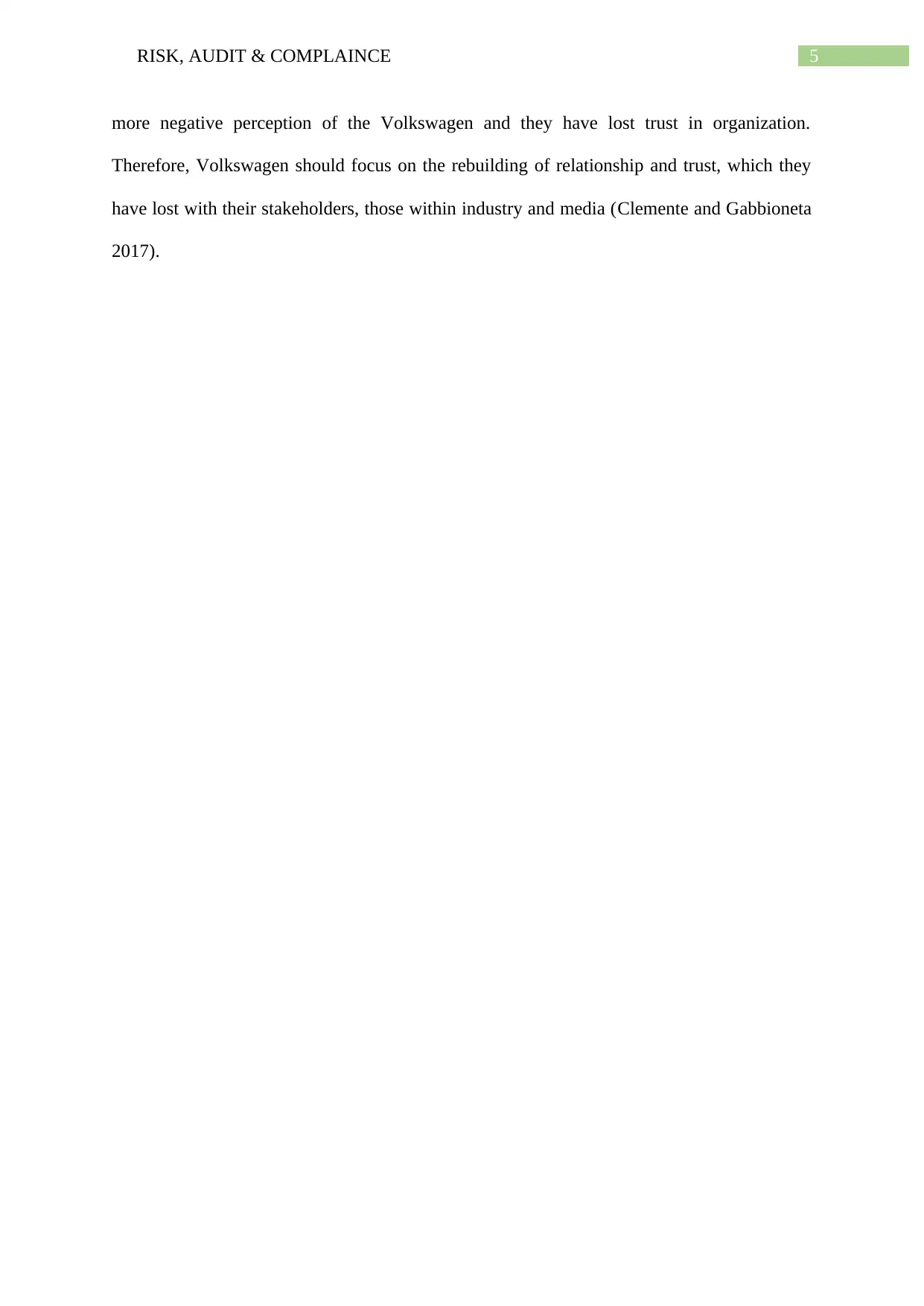
5RISK, AUDIT & COMPLAINCE
more negative perception of the Volkswagen and they have lost trust in organization.
Therefore, Volkswagen should focus on the rebuilding of relationship and trust, which they
have lost with their stakeholders, those within industry and media (Clemente and Gabbioneta
2017).
more negative perception of the Volkswagen and they have lost trust in organization.
Therefore, Volkswagen should focus on the rebuilding of relationship and trust, which they
have lost with their stakeholders, those within industry and media (Clemente and Gabbioneta
2017).
⊘ This is a preview!⊘
Do you want full access?
Subscribe today to unlock all pages.

Trusted by 1+ million students worldwide
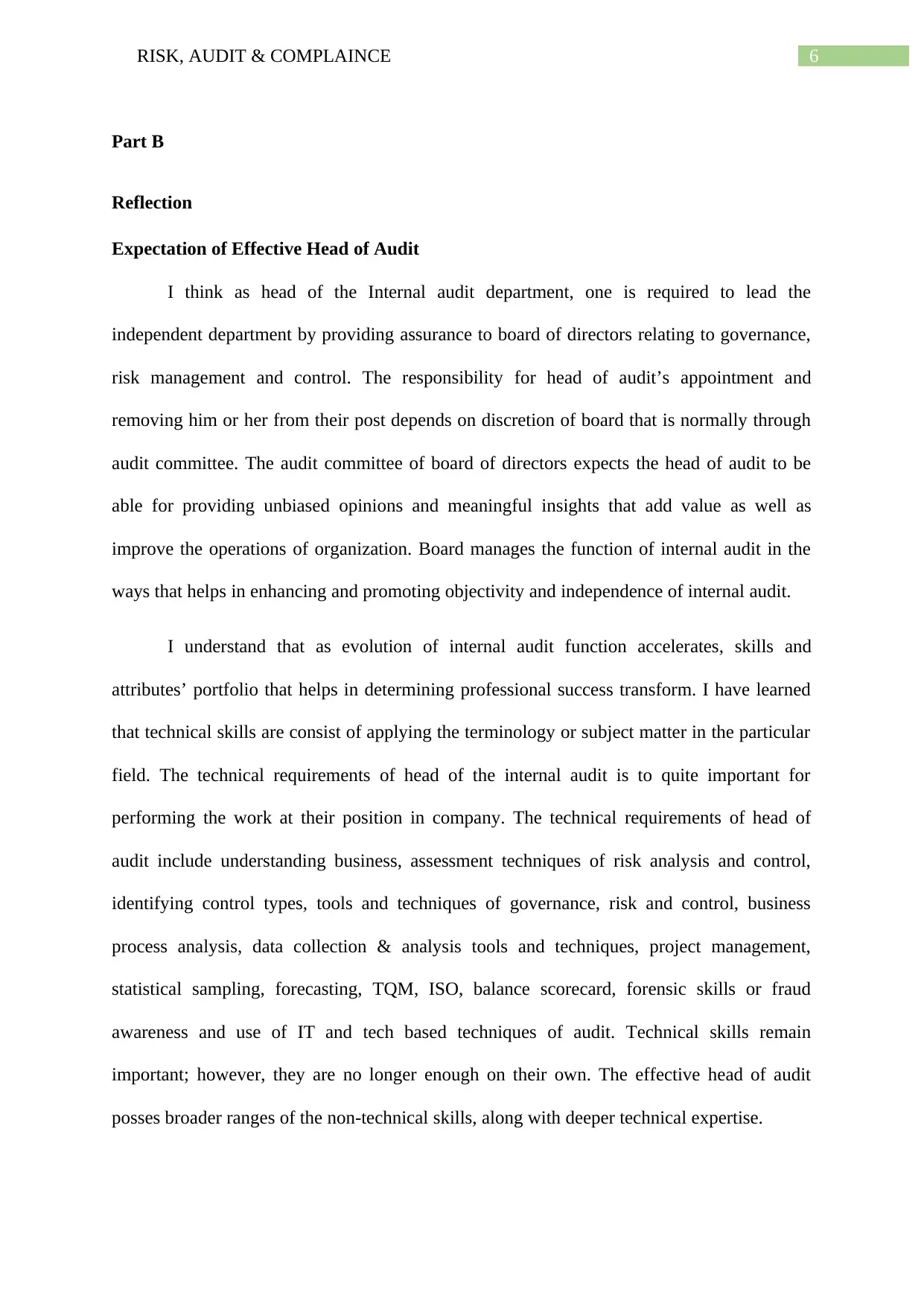
6RISK, AUDIT & COMPLAINCE
Part B
Reflection
Expectation of Effective Head of Audit
I think as head of the Internal audit department, one is required to lead the
independent department by providing assurance to board of directors relating to governance,
risk management and control. The responsibility for head of audit’s appointment and
removing him or her from their post depends on discretion of board that is normally through
audit committee. The audit committee of board of directors expects the head of audit to be
able for providing unbiased opinions and meaningful insights that add value as well as
improve the operations of organization. Board manages the function of internal audit in the
ways that helps in enhancing and promoting objectivity and independence of internal audit.
I understand that as evolution of internal audit function accelerates, skills and
attributes’ portfolio that helps in determining professional success transform. I have learned
that technical skills are consist of applying the terminology or subject matter in the particular
field. The technical requirements of head of the internal audit is to quite important for
performing the work at their position in company. The technical requirements of head of
audit include understanding business, assessment techniques of risk analysis and control,
identifying control types, tools and techniques of governance, risk and control, business
process analysis, data collection & analysis tools and techniques, project management,
statistical sampling, forecasting, TQM, ISO, balance scorecard, forensic skills or fraud
awareness and use of IT and tech based techniques of audit. Technical skills remain
important; however, they are no longer enough on their own. The effective head of audit
posses broader ranges of the non-technical skills, along with deeper technical expertise.
Part B
Reflection
Expectation of Effective Head of Audit
I think as head of the Internal audit department, one is required to lead the
independent department by providing assurance to board of directors relating to governance,
risk management and control. The responsibility for head of audit’s appointment and
removing him or her from their post depends on discretion of board that is normally through
audit committee. The audit committee of board of directors expects the head of audit to be
able for providing unbiased opinions and meaningful insights that add value as well as
improve the operations of organization. Board manages the function of internal audit in the
ways that helps in enhancing and promoting objectivity and independence of internal audit.
I understand that as evolution of internal audit function accelerates, skills and
attributes’ portfolio that helps in determining professional success transform. I have learned
that technical skills are consist of applying the terminology or subject matter in the particular
field. The technical requirements of head of the internal audit is to quite important for
performing the work at their position in company. The technical requirements of head of
audit include understanding business, assessment techniques of risk analysis and control,
identifying control types, tools and techniques of governance, risk and control, business
process analysis, data collection & analysis tools and techniques, project management,
statistical sampling, forecasting, TQM, ISO, balance scorecard, forensic skills or fraud
awareness and use of IT and tech based techniques of audit. Technical skills remain
important; however, they are no longer enough on their own. The effective head of audit
posses broader ranges of the non-technical skills, along with deeper technical expertise.
Paraphrase This Document
Need a fresh take? Get an instant paraphrase of this document with our AI Paraphraser
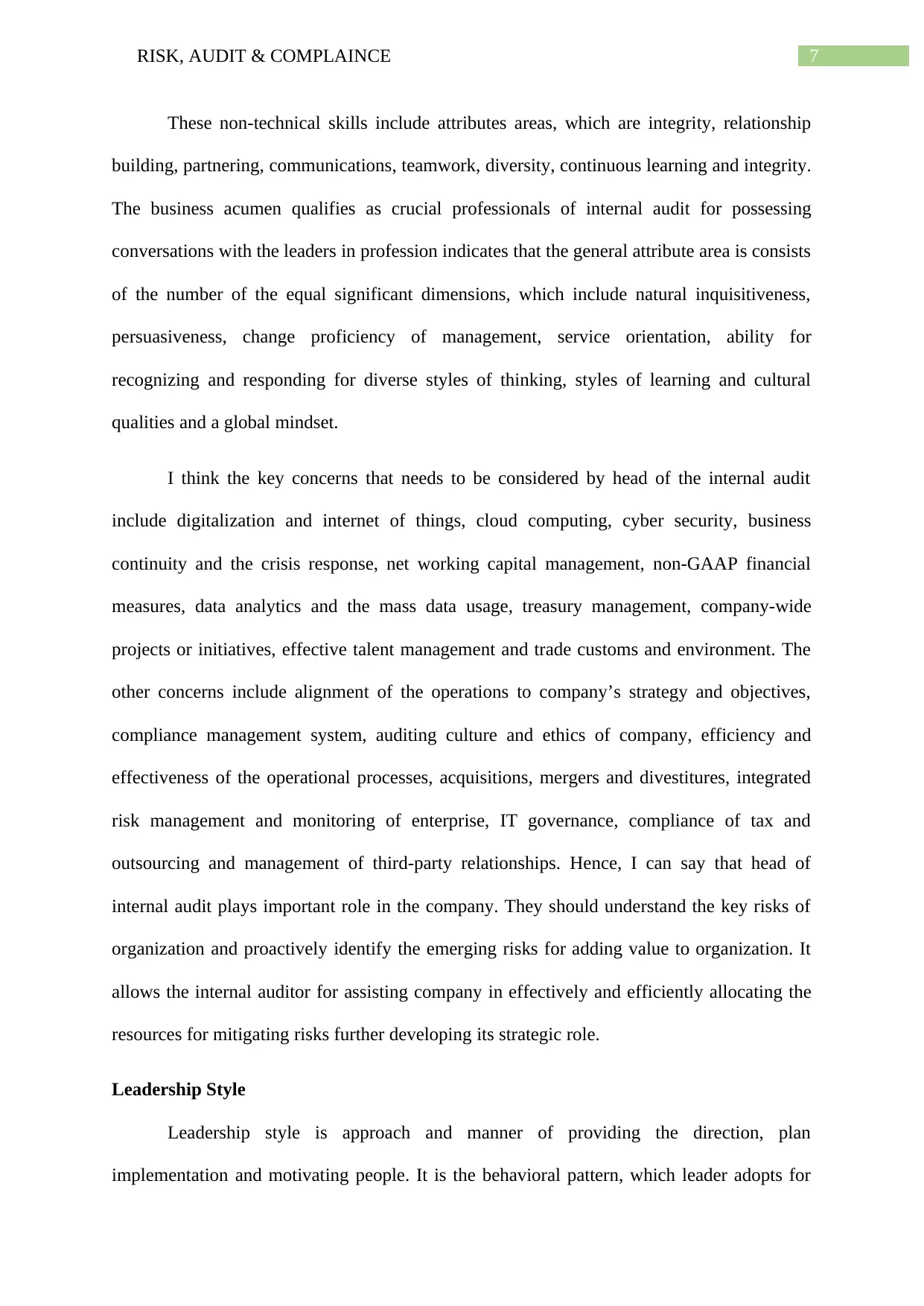
7RISK, AUDIT & COMPLAINCE
These non-technical skills include attributes areas, which are integrity, relationship
building, partnering, communications, teamwork, diversity, continuous learning and integrity.
The business acumen qualifies as crucial professionals of internal audit for possessing
conversations with the leaders in profession indicates that the general attribute area is consists
of the number of the equal significant dimensions, which include natural inquisitiveness,
persuasiveness, change proficiency of management, service orientation, ability for
recognizing and responding for diverse styles of thinking, styles of learning and cultural
qualities and a global mindset.
I think the key concerns that needs to be considered by head of the internal audit
include digitalization and internet of things, cloud computing, cyber security, business
continuity and the crisis response, net working capital management, non-GAAP financial
measures, data analytics and the mass data usage, treasury management, company-wide
projects or initiatives, effective talent management and trade customs and environment. The
other concerns include alignment of the operations to company’s strategy and objectives,
compliance management system, auditing culture and ethics of company, efficiency and
effectiveness of the operational processes, acquisitions, mergers and divestitures, integrated
risk management and monitoring of enterprise, IT governance, compliance of tax and
outsourcing and management of third-party relationships. Hence, I can say that head of
internal audit plays important role in the company. They should understand the key risks of
organization and proactively identify the emerging risks for adding value to organization. It
allows the internal auditor for assisting company in effectively and efficiently allocating the
resources for mitigating risks further developing its strategic role.
Leadership Style
Leadership style is approach and manner of providing the direction, plan
implementation and motivating people. It is the behavioral pattern, which leader adopts for
These non-technical skills include attributes areas, which are integrity, relationship
building, partnering, communications, teamwork, diversity, continuous learning and integrity.
The business acumen qualifies as crucial professionals of internal audit for possessing
conversations with the leaders in profession indicates that the general attribute area is consists
of the number of the equal significant dimensions, which include natural inquisitiveness,
persuasiveness, change proficiency of management, service orientation, ability for
recognizing and responding for diverse styles of thinking, styles of learning and cultural
qualities and a global mindset.
I think the key concerns that needs to be considered by head of the internal audit
include digitalization and internet of things, cloud computing, cyber security, business
continuity and the crisis response, net working capital management, non-GAAP financial
measures, data analytics and the mass data usage, treasury management, company-wide
projects or initiatives, effective talent management and trade customs and environment. The
other concerns include alignment of the operations to company’s strategy and objectives,
compliance management system, auditing culture and ethics of company, efficiency and
effectiveness of the operational processes, acquisitions, mergers and divestitures, integrated
risk management and monitoring of enterprise, IT governance, compliance of tax and
outsourcing and management of third-party relationships. Hence, I can say that head of
internal audit plays important role in the company. They should understand the key risks of
organization and proactively identify the emerging risks for adding value to organization. It
allows the internal auditor for assisting company in effectively and efficiently allocating the
resources for mitigating risks further developing its strategic role.
Leadership Style
Leadership style is approach and manner of providing the direction, plan
implementation and motivating people. It is the behavioral pattern, which leader adopts for
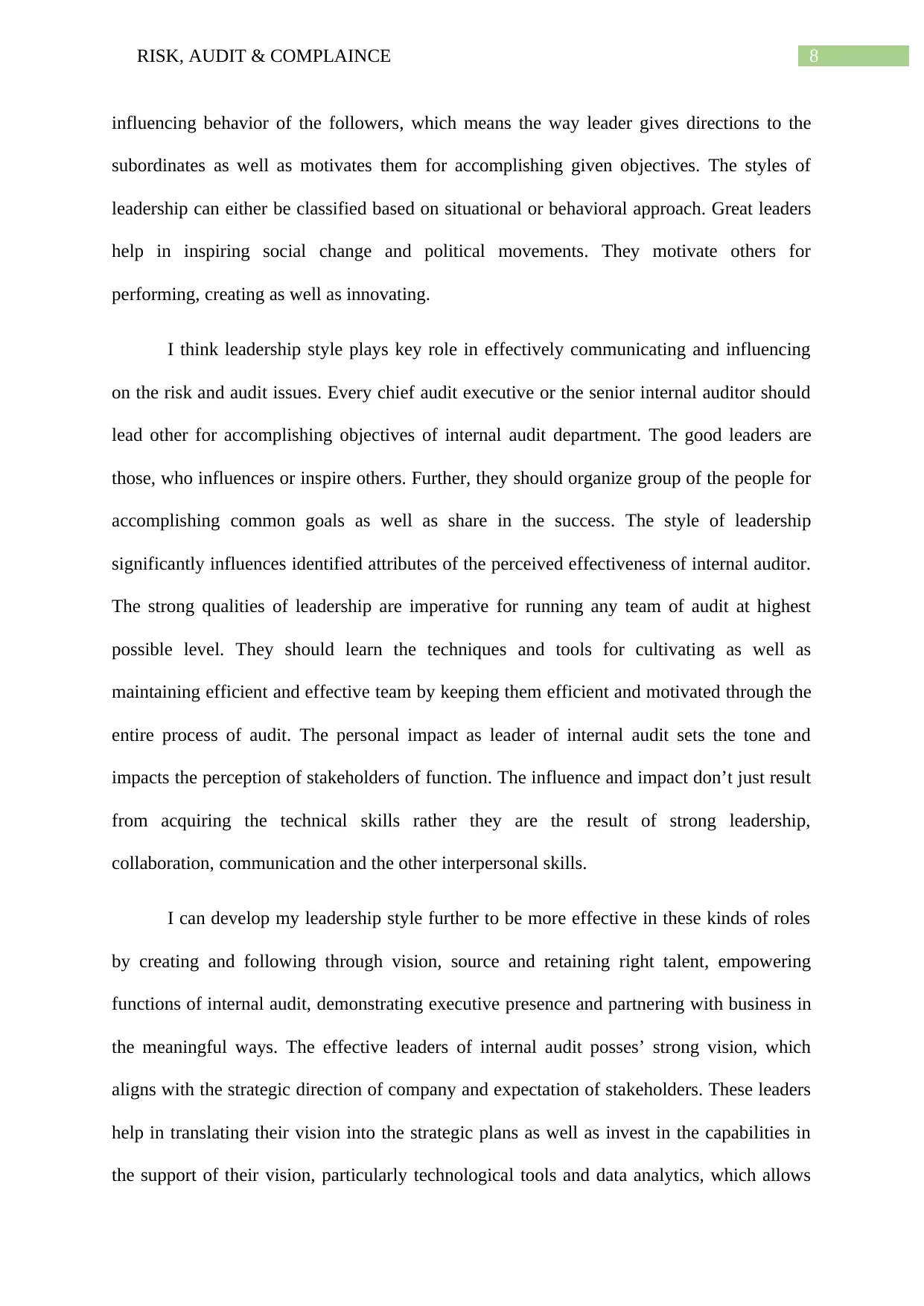
8RISK, AUDIT & COMPLAINCE
influencing behavior of the followers, which means the way leader gives directions to the
subordinates as well as motivates them for accomplishing given objectives. The styles of
leadership can either be classified based on situational or behavioral approach. Great leaders
help in inspiring social change and political movements. They motivate others for
performing, creating as well as innovating.
I think leadership style plays key role in effectively communicating and influencing
on the risk and audit issues. Every chief audit executive or the senior internal auditor should
lead other for accomplishing objectives of internal audit department. The good leaders are
those, who influences or inspire others. Further, they should organize group of the people for
accomplishing common goals as well as share in the success. The style of leadership
significantly influences identified attributes of the perceived effectiveness of internal auditor.
The strong qualities of leadership are imperative for running any team of audit at highest
possible level. They should learn the techniques and tools for cultivating as well as
maintaining efficient and effective team by keeping them efficient and motivated through the
entire process of audit. The personal impact as leader of internal audit sets the tone and
impacts the perception of stakeholders of function. The influence and impact don’t just result
from acquiring the technical skills rather they are the result of strong leadership,
collaboration, communication and the other interpersonal skills.
I can develop my leadership style further to be more effective in these kinds of roles
by creating and following through vision, source and retaining right talent, empowering
functions of internal audit, demonstrating executive presence and partnering with business in
the meaningful ways. The effective leaders of internal audit posses’ strong vision, which
aligns with the strategic direction of company and expectation of stakeholders. These leaders
help in translating their vision into the strategic plans as well as invest in the capabilities in
the support of their vision, particularly technological tools and data analytics, which allows
influencing behavior of the followers, which means the way leader gives directions to the
subordinates as well as motivates them for accomplishing given objectives. The styles of
leadership can either be classified based on situational or behavioral approach. Great leaders
help in inspiring social change and political movements. They motivate others for
performing, creating as well as innovating.
I think leadership style plays key role in effectively communicating and influencing
on the risk and audit issues. Every chief audit executive or the senior internal auditor should
lead other for accomplishing objectives of internal audit department. The good leaders are
those, who influences or inspire others. Further, they should organize group of the people for
accomplishing common goals as well as share in the success. The style of leadership
significantly influences identified attributes of the perceived effectiveness of internal auditor.
The strong qualities of leadership are imperative for running any team of audit at highest
possible level. They should learn the techniques and tools for cultivating as well as
maintaining efficient and effective team by keeping them efficient and motivated through the
entire process of audit. The personal impact as leader of internal audit sets the tone and
impacts the perception of stakeholders of function. The influence and impact don’t just result
from acquiring the technical skills rather they are the result of strong leadership,
collaboration, communication and the other interpersonal skills.
I can develop my leadership style further to be more effective in these kinds of roles
by creating and following through vision, source and retaining right talent, empowering
functions of internal audit, demonstrating executive presence and partnering with business in
the meaningful ways. The effective leaders of internal audit posses’ strong vision, which
aligns with the strategic direction of company and expectation of stakeholders. These leaders
help in translating their vision into the strategic plans as well as invest in the capabilities in
the support of their vision, particularly technological tools and data analytics, which allows
⊘ This is a preview!⊘
Do you want full access?
Subscribe today to unlock all pages.

Trusted by 1+ million students worldwide
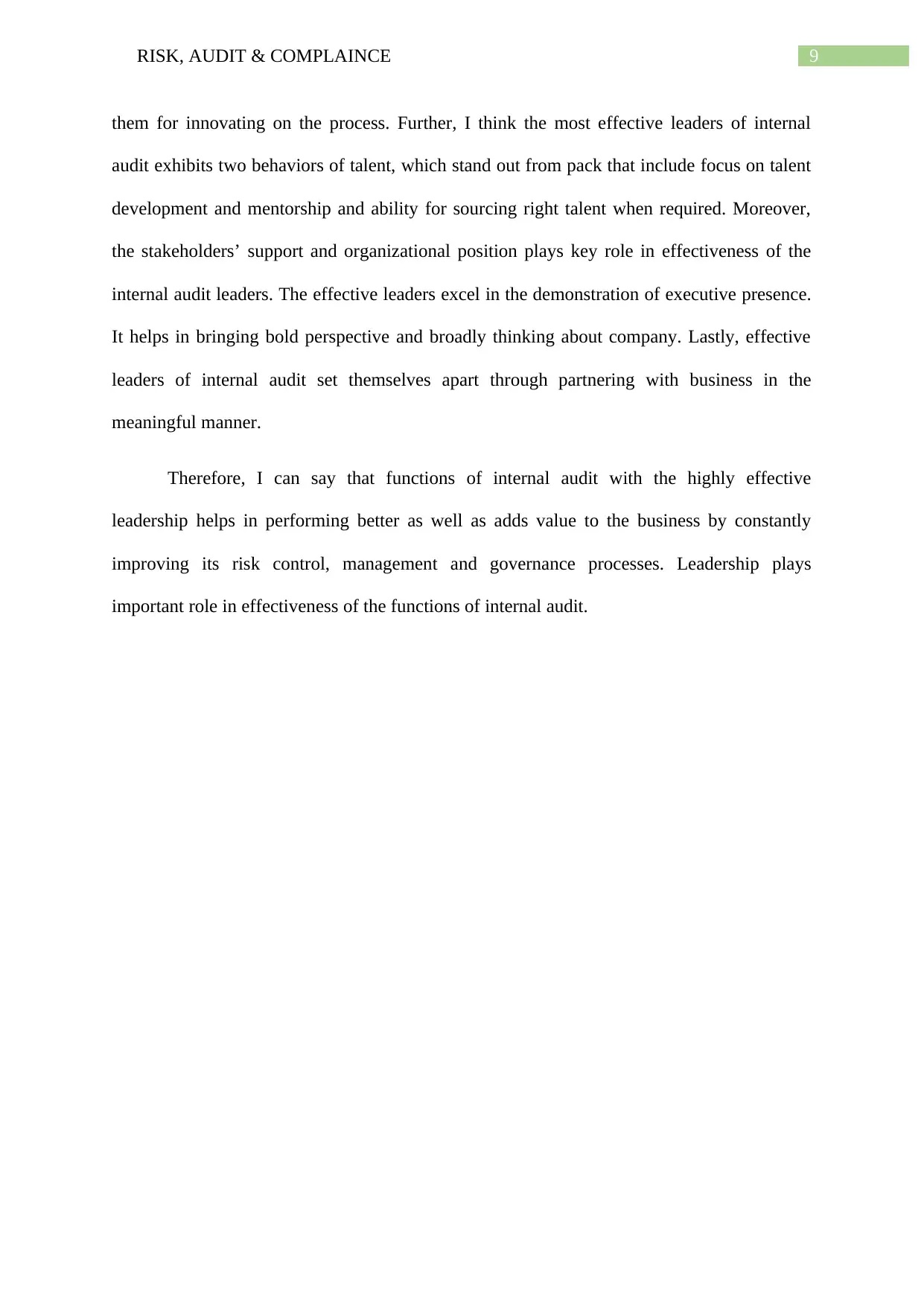
9RISK, AUDIT & COMPLAINCE
them for innovating on the process. Further, I think the most effective leaders of internal
audit exhibits two behaviors of talent, which stand out from pack that include focus on talent
development and mentorship and ability for sourcing right talent when required. Moreover,
the stakeholders’ support and organizational position plays key role in effectiveness of the
internal audit leaders. The effective leaders excel in the demonstration of executive presence.
It helps in bringing bold perspective and broadly thinking about company. Lastly, effective
leaders of internal audit set themselves apart through partnering with business in the
meaningful manner.
Therefore, I can say that functions of internal audit with the highly effective
leadership helps in performing better as well as adds value to the business by constantly
improving its risk control, management and governance processes. Leadership plays
important role in effectiveness of the functions of internal audit.
them for innovating on the process. Further, I think the most effective leaders of internal
audit exhibits two behaviors of talent, which stand out from pack that include focus on talent
development and mentorship and ability for sourcing right talent when required. Moreover,
the stakeholders’ support and organizational position plays key role in effectiveness of the
internal audit leaders. The effective leaders excel in the demonstration of executive presence.
It helps in bringing bold perspective and broadly thinking about company. Lastly, effective
leaders of internal audit set themselves apart through partnering with business in the
meaningful manner.
Therefore, I can say that functions of internal audit with the highly effective
leadership helps in performing better as well as adds value to the business by constantly
improving its risk control, management and governance processes. Leadership plays
important role in effectiveness of the functions of internal audit.
Paraphrase This Document
Need a fresh take? Get an instant paraphrase of this document with our AI Paraphraser
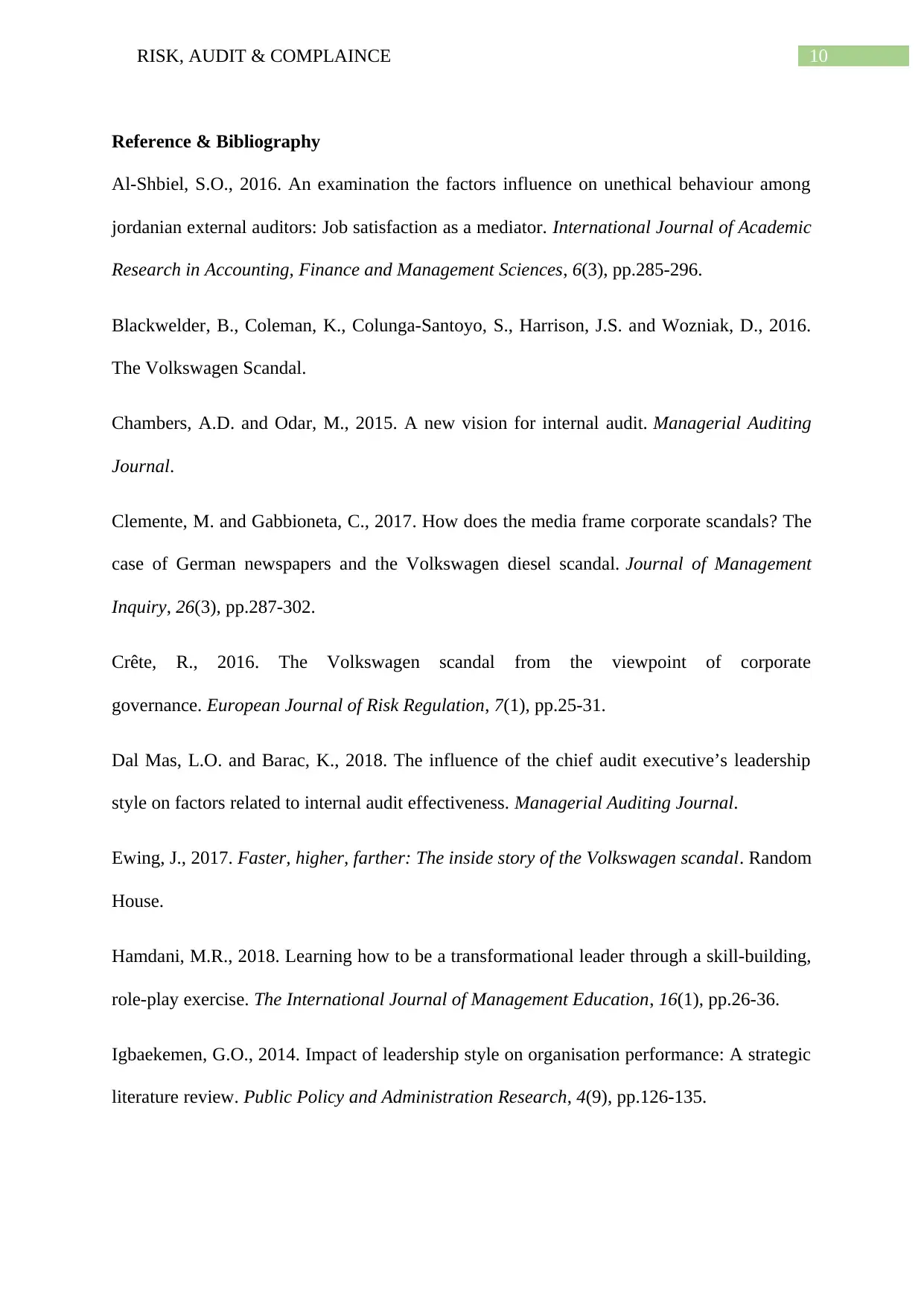
10RISK, AUDIT & COMPLAINCE
Reference & Bibliography
Al-Shbiel, S.O., 2016. An examination the factors influence on unethical behaviour among
jordanian external auditors: Job satisfaction as a mediator. International Journal of Academic
Research in Accounting, Finance and Management Sciences, 6(3), pp.285-296.
Blackwelder, B., Coleman, K., Colunga-Santoyo, S., Harrison, J.S. and Wozniak, D., 2016.
The Volkswagen Scandal.
Chambers, A.D. and Odar, M., 2015. A new vision for internal audit. Managerial Auditing
Journal.
Clemente, M. and Gabbioneta, C., 2017. How does the media frame corporate scandals? The
case of German newspapers and the Volkswagen diesel scandal. Journal of Management
Inquiry, 26(3), pp.287-302.
Crête, R., 2016. The Volkswagen scandal from the viewpoint of corporate
governance. European Journal of Risk Regulation, 7(1), pp.25-31.
Dal Mas, L.O. and Barac, K., 2018. The influence of the chief audit executive’s leadership
style on factors related to internal audit effectiveness. Managerial Auditing Journal.
Ewing, J., 2017. Faster, higher, farther: The inside story of the Volkswagen scandal. Random
House.
Hamdani, M.R., 2018. Learning how to be a transformational leader through a skill-building,
role-play exercise. The International Journal of Management Education, 16(1), pp.26-36.
Igbaekemen, G.O., 2014. Impact of leadership style on organisation performance: A strategic
literature review. Public Policy and Administration Research, 4(9), pp.126-135.
Reference & Bibliography
Al-Shbiel, S.O., 2016. An examination the factors influence on unethical behaviour among
jordanian external auditors: Job satisfaction as a mediator. International Journal of Academic
Research in Accounting, Finance and Management Sciences, 6(3), pp.285-296.
Blackwelder, B., Coleman, K., Colunga-Santoyo, S., Harrison, J.S. and Wozniak, D., 2016.
The Volkswagen Scandal.
Chambers, A.D. and Odar, M., 2015. A new vision for internal audit. Managerial Auditing
Journal.
Clemente, M. and Gabbioneta, C., 2017. How does the media frame corporate scandals? The
case of German newspapers and the Volkswagen diesel scandal. Journal of Management
Inquiry, 26(3), pp.287-302.
Crête, R., 2016. The Volkswagen scandal from the viewpoint of corporate
governance. European Journal of Risk Regulation, 7(1), pp.25-31.
Dal Mas, L.O. and Barac, K., 2018. The influence of the chief audit executive’s leadership
style on factors related to internal audit effectiveness. Managerial Auditing Journal.
Ewing, J., 2017. Faster, higher, farther: The inside story of the Volkswagen scandal. Random
House.
Hamdani, M.R., 2018. Learning how to be a transformational leader through a skill-building,
role-play exercise. The International Journal of Management Education, 16(1), pp.26-36.
Igbaekemen, G.O., 2014. Impact of leadership style on organisation performance: A strategic
literature review. Public Policy and Administration Research, 4(9), pp.126-135.
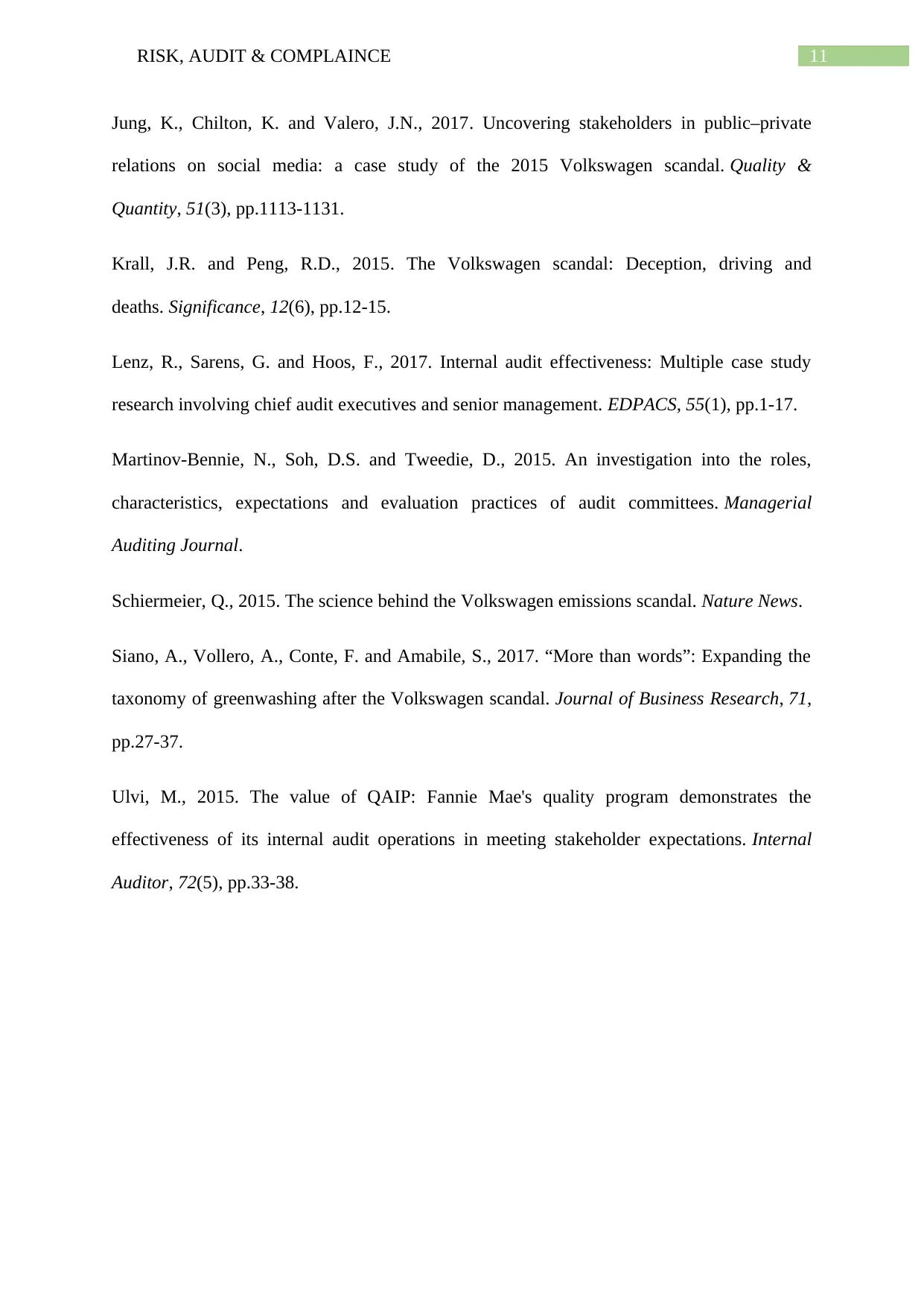
11RISK, AUDIT & COMPLAINCE
Jung, K., Chilton, K. and Valero, J.N., 2017. Uncovering stakeholders in public–private
relations on social media: a case study of the 2015 Volkswagen scandal. Quality &
Quantity, 51(3), pp.1113-1131.
Krall, J.R. and Peng, R.D., 2015. The Volkswagen scandal: Deception, driving and
deaths. Significance, 12(6), pp.12-15.
Lenz, R., Sarens, G. and Hoos, F., 2017. Internal audit effectiveness: Multiple case study
research involving chief audit executives and senior management. EDPACS, 55(1), pp.1-17.
Martinov-Bennie, N., Soh, D.S. and Tweedie, D., 2015. An investigation into the roles,
characteristics, expectations and evaluation practices of audit committees. Managerial
Auditing Journal.
Schiermeier, Q., 2015. The science behind the Volkswagen emissions scandal. Nature News.
Siano, A., Vollero, A., Conte, F. and Amabile, S., 2017. “More than words”: Expanding the
taxonomy of greenwashing after the Volkswagen scandal. Journal of Business Research, 71,
pp.27-37.
Ulvi, M., 2015. The value of QAIP: Fannie Mae's quality program demonstrates the
effectiveness of its internal audit operations in meeting stakeholder expectations. Internal
Auditor, 72(5), pp.33-38.
Jung, K., Chilton, K. and Valero, J.N., 2017. Uncovering stakeholders in public–private
relations on social media: a case study of the 2015 Volkswagen scandal. Quality &
Quantity, 51(3), pp.1113-1131.
Krall, J.R. and Peng, R.D., 2015. The Volkswagen scandal: Deception, driving and
deaths. Significance, 12(6), pp.12-15.
Lenz, R., Sarens, G. and Hoos, F., 2017. Internal audit effectiveness: Multiple case study
research involving chief audit executives and senior management. EDPACS, 55(1), pp.1-17.
Martinov-Bennie, N., Soh, D.S. and Tweedie, D., 2015. An investigation into the roles,
characteristics, expectations and evaluation practices of audit committees. Managerial
Auditing Journal.
Schiermeier, Q., 2015. The science behind the Volkswagen emissions scandal. Nature News.
Siano, A., Vollero, A., Conte, F. and Amabile, S., 2017. “More than words”: Expanding the
taxonomy of greenwashing after the Volkswagen scandal. Journal of Business Research, 71,
pp.27-37.
Ulvi, M., 2015. The value of QAIP: Fannie Mae's quality program demonstrates the
effectiveness of its internal audit operations in meeting stakeholder expectations. Internal
Auditor, 72(5), pp.33-38.
⊘ This is a preview!⊘
Do you want full access?
Subscribe today to unlock all pages.

Trusted by 1+ million students worldwide
1 out of 12
Related Documents
Your All-in-One AI-Powered Toolkit for Academic Success.
+13062052269
info@desklib.com
Available 24*7 on WhatsApp / Email
![[object Object]](/_next/static/media/star-bottom.7253800d.svg)
Unlock your academic potential
Copyright © 2020–2025 A2Z Services. All Rights Reserved. Developed and managed by ZUCOL.





